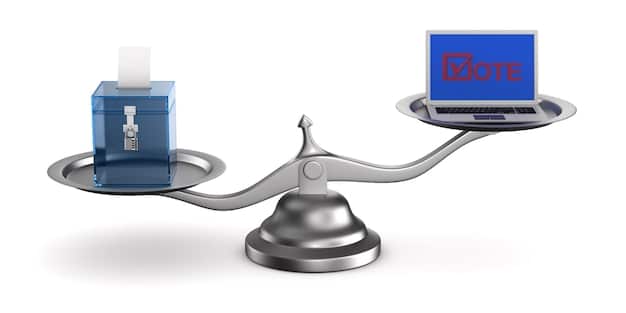The Impact of AI on US Democracy: Strengthening or Undermining?

The impact of AI on US democracy is a complex equation involving both potential benefits like increased voter engagement and significant risks such as the spread of misinformation and voter manipulation, necessitating careful consideration and proactive measures.
The rise of artificial intelligence (AI) presents both unprecedented opportunities and potential threats to the foundations of democracy in the United States. From enhancing voter engagement to spreading disinformation, the impact of AI on US democracy: will algorithms strengthen or undermine voting? is a question that demands urgent attention and careful consideration.
AI and Voter Engagement
AI has the potential to revolutionize voter engagement strategies. By analyzing voter data, AI can help campaigns identify and target specific demographics with tailored messages, potentially increasing turnout and participation in elections.
Personalized Voter Outreach
AI algorithms can sift through vast amounts of data to understand individual voter preferences and concerns, enabling campaigns to deliver personalized messages that resonate with specific voters.
AI-Powered Chatbots
AI-powered chatbots can provide instant answers to voter inquiries, helping to clarify complex election procedures and address common misconceptions. This accessibility can particularly benefit first-time voters or those with limited access to traditional sources of information.
- AI chatbots can answer questions about voter registration, polling locations, and ballot initiatives.
- Personalized responses based on voter location and demographic information.
- 24/7 Availability, ensuring voters can access information at any time.
- Multilingual support to cater to diverse communities.
However, the use of AI in voter engagement also raises ethical concerns. The potential for manipulation through targeted messaging and the risk of creating echo chambers are significant challenges that need to be addressed.
Combating Disinformation with AI
One of the most pressing challenges facing US democracy today is the spread of disinformation. AI offers powerful tools to combat this threat by detecting and flagging false or misleading information.

AI-Driven Fact-Checking
AI can be used to automatically verify the accuracy of claims made in news articles, social media posts, and political advertisements. By comparing statements against a database of verified facts, AI can quickly identify potential instances of disinformation.
Monitoring Social Media
AI algorithms can monitor social media platforms for suspicious activity and identify patterns of disinformation dissemination. This can help to disrupt the spread of false information before it reaches a wider audience.
However, relying solely on AI to combat disinformation is not without its limitations. AI algorithms can be biased, and they may struggle to distinguish between satire and genuine disinformation. Human oversight is essential to ensure accuracy and fairness.
The Risk of AI-Generated Misinformation
While AI can be a valuable tool in combating disinformation, it can also be used to create and disseminate false information at an unprecedented scale. AI-generated deepfakes and other forms of synthetic media pose a significant threat to the integrity of US elections.
Deepfakes and Synthetic Media
AI-generated deepfakes can create realistic but entirely fabricated videos and audio recordings of political figures, potentially misleading voters and influencing election outcomes.
Detecting Deepfakes
The race to create and detect deepfakes is an ongoing arms race. AI algorithms are constantly evolving, making it increasingly difficult to distinguish between authentic and synthetic media. Specialized AI tools are being developed to analyze videos and audio for telltale signs of manipulation.
- Analyzing facial movements and expressions for inconsistencies.
- Examining audio waveforms for artifacts of AI generation.
- Cross-referencing content with verified sources.
The creation and dissemination of AI-generated misinformation can erode public trust in democratic institutions and make it more difficult for voters to make informed decisions. Education and awareness campaigns are crucial to help citizens identify and resist these deceptive tactics.
Algorithmic Bias and Voter Suppression
AI algorithms are trained on data, and if that data reflects existing biases, the algorithms will perpetuate and amplify those biases. This can lead to discriminatory outcomes in voter registration, access to polling places, and other aspects of the electoral process.

Identifying and Mitigating Bias
Addressing algorithmic bias requires careful attention to the data used to train AI algorithms. Diversifying datasets and implementing bias detection and mitigation techniques are essential steps.
Auditing Algorithms
Regular audits of AI algorithms are necessary to ensure they are not producing discriminatory outcomes. These audits should involve independent experts who can assess the fairness and accuracy of the algorithms.
Algorithmic bias can disproportionately affect marginalized communities, leading to voter suppression and undermining the principle of equal representation. Ensuring fairness and equity in AI-driven electoral processes is a critical challenge for US democracy.
The Role of Regulations and Oversight
To harness the benefits of AI while mitigating its risks, clear regulations and effective oversight mechanisms are needed. This includes establishing standards for transparency, accountability, and ethical use of AI in elections.
Transparency in AI Use
Transparency is essential to ensure that AI is used responsibly in elections. Campaigns and organizations should be required to disclose when they are using AI to target voters or disseminate information.
Establishing Ethical Guidelines
Developing ethical guidelines for the use of AI in elections can help to prevent manipulation and ensure fairness. These guidelines should address issues such as transparency, accountability, and non-discrimination.
- Defining clear boundaries for AI use in political campaigns.
- Establishing independent oversight bodies to monitor AI applications.
- Promoting public awareness of AI’s potential impact on democracy.
Effective regulations and oversight can help to safeguard the integrity of US elections in the age of AI. Without these safeguards, the potential for misuse and abuse is significant.
The Future of AI and US Elections
As AI technology continues to evolve, its impact on US elections is likely to become even more profound. Preparing for this future requires ongoing research, education, and dialogue among policymakers, technologists, and the public.
Investing in Research
Continued research is needed to understand the full potential and risks of AI in elections. This research should focus on developing new methods for detecting and combating disinformation, mitigating algorithmic bias, and promoting transparency and accountability.
Promoting Digital Literacy
Empowering citizens with digital literacy skills is essential to help them navigate the complex information landscape and resist manipulation. Education campaigns should focus on teaching critical thinking, media literacy, and online safety.
The future of AI and US elections depends on our ability to harness its benefits while mitigating its risks. By embracing a proactive and informed approach, we can ensure that AI strengthens, rather than undermines, the foundations of democracy.
In conclusion, navigating the complexities of AI’s impact on US democracy requires a balanced approach. While AI offers potential benefits in voter engagement and combating disinformation, it also poses significant risks, including the spread of misinformation and algorithmic bias. Regulations, oversight, and public education are essential to ensuring AI enhances, rather than undermines, democratic processes.
| Key Aspect | Brief Description |
|---|---|
| 🗳️ Voter Engagement | AI can personalize outreach to increase voter turnout. |
| 🛡️ Combating Misinformation | AI aids in detecting and flagging false information. |
| ⚠️ AI-Generated Risks | Deepfakes and synthetic media pose a threat. |
| ⚖️ Algorithmic Bias | Bias in data can lead to voter suppression. |
Frequently Asked Questions
▼
AI can analyze voter data to deliver personalized messages, increasing turnout by targeting specific demographics with tailored information.
▼
AI can create deepfakes and synthetic media, spreading false information that erodes public trust and manipulates voters.
▼
Algorithmic bias can perpetuate existing inequalities, leading to voter suppression and disproportionately affecting marginalized communities.
▼
Regulations should focus on transparency, accountability, and ethical use to prevent manipulation and ensure AI is used responsibly.
▼
AI can automatically verify the accuracy of claims and monitor social media for suspicious activity, helping disrupt the spread of false information.
Conclusion
In conclusion, the integration of AI into US democracy presents a dual-edged sword. While AI offers immense potential for enhancing voter engagement and combating disinformation, it simultaneously introduces risks such as the proliferation of AI-generated misinformation and the perpetuation of algorithmic bias. Addressing these challenges through proactive regulations, stringent oversight, and comprehensive public education is paramount to ensuring that AI serves to strengthen, rather than undermine, the foundations of American democracy.





